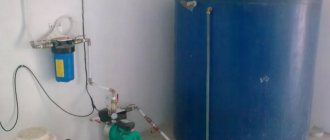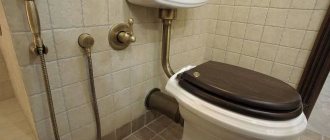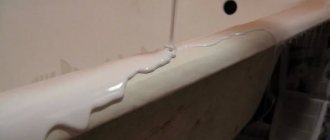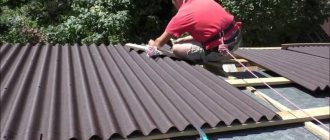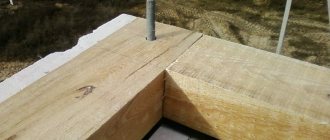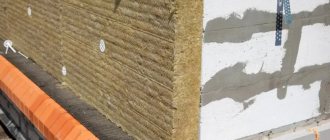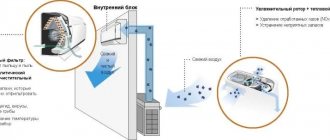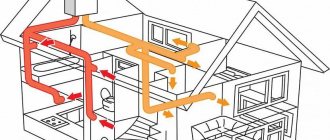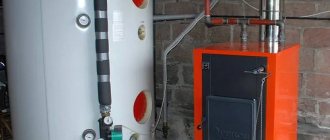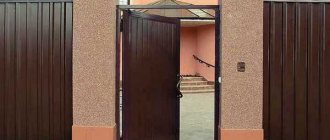There was already a little bit about fastening to the hollow PGP. Let's expand the topic a little and talk about fastening to hollow materials in general. In addition to slotted bricks, for example.
Here's what to do if you need to hang a sink or even a boiler, and you know that they will be held by a thin ceramic wall? The thickness of the expansion anchors does not solve anything here. Of course, the anchor itself can withstand a lot. And even at first it will keep your boiler running. But the problem with attaching to hollow materials is that the weakest point in this case is the wall. Under the weight of the structure, the wall will simply burst and the anchor (in one piece, mind you!) will fall along with the boiler. Do you need it? Then we'll figure out how to deal with it.
We immediately reject the option with continuous drilling and a pin. This is not possible everywhere. What remains is a chemical anchor. It's reliable. And at the same time very expensive. If you don’t want to spend money on a ready-made solution, you can try to save some money without losing quality.
All methods of attaching to hollow materials come down to approximately one idea: at the attachment point you need to fill the cavity with something. In the material with PGP it was gypsum. Bricks can be filled with tile adhesive. Dilute it (just not thickly), put it into a sealant tube, and fill it with a gun through a pre-drilled hole. By the way, it is better to drill without impact, so as not to break the brick wall. A plastic dowel is inserted into the still wet glue. Anything that gets pushed inside the dowel will need to be cleaned out. Tomorrow, when the glue has hardened, you can screw the self-tapping screw into the dowel.
Another option is to use liquid nails instead of tile adhesive. The principle is the same. Fill the cavity through the tube until it hardens and insert the dowel.
Liquid nails based on synthetic rubber and polymers are a type of glue for construction work. Liquid nails contain a fine-grained filler, which distinguishes this type of construction fastening from simple glue or metal nails; moreover, it allows you to fasten parts that are not tightly adjacent to each other, and also withstand enormous loads. Even a very small amount of liquid nail composition can hold up to 50 kg of weight.
Today there are two types of construction fastenings:
- Water based. Acrylic water-based nails. They are environmentally friendly, but are not suitable for all types of building materials and, oddly enough, they are afraid of moisture. Suitable for gluing materials with a porous structure (tiles, etc.).
- Neoprene liquid nails have an organic solvent as their main element. They are hazardous to health and have a persistent, peculiar odor. But they are suitable for almost any material and can withstand enormous weights.
There are some differences between the types of liquid nails. Let's look at them:
Suitable only for plastic (plastic) and can only be used in dry structures.
- Resistant to fungus and moisture resistant
- Environmentally friendly and harmless.
- Suitable for all surfaces
- They set very quickly and have high strength.
All liquid nails have a number of advantages and disadvantages, for example, it is almost impossible for them to damage the surface of materials, they are suitable for all types of construction work, internal and external, they have excellent strength, they glue most building materials
Liquid nails are used in a wide range of construction works as they perfectly glue various materials (brick, plastics, ceramic tiles, metal, glass, drywall, wood, etc.). With rare exceptions, they can be used for sealing purposes.
A chemical anchor is essentially an adhesive mixture (made of synthetic resin) filled into a cartridge or ampoule. It is like a binding substance between the material and metal construction fasteners.
The principle of operation of a chemical anchor is quite simple: the adhesive composition, complete with a metal fastener, passes into the drilled hole in the material. Having hardened, it reliably bonds the material and the anchor to form a strong monolithic connection.
The characteristics of a chemical anchor are much superior to standard construction fasteners, it has excellent load-bearing capabilities and can withstand heavy loads. Thanks to its properties, chemical anchors are now so popular among professional builders. There are no limits to the reliability and strength of chemical anchors; they are used for fastening balconies and in the installation of bridges. The hardening speed is usually from a day to a couple of hours, different mixtures have different values.
The main advantages of chemical anchors:
- Can be used in wet environments (underwater)
- Reliable fixation, excellent for porous materials (aerated concrete and foam concrete)
- Stronger than mechanical anchors
- Does not create mechanical pressure (does not push the walls of the hole)
- Indispensable when working on the edges of structures (parapets, railings, etc.)
- Chemically resistant in aggressive environments (alkali, water)
- Has the ability to seal the connection
- Suitable for mounting rebars
- The chemical anchor is very durable and has a service life of more than 50 years.
As an alternative solution for fastening building and repair structures, liquid anchors have been successfully used, which have gained a reputation as an optimal alternative to mechanical methods. The fastening principle is based on the hardening of a special liquid, which is pre-installed into the required mechanism. The use of such material eliminates the use of spacers. This will avoid the deformation stress that appears with traditional joining and fastening methods.
Anchor fixation technology
A special device is being prepared. When using a special dispenser, the liquid anchor fills the hole. The required material is inserted inside - a metal rod, fittings, a pin, etc. The liquid mass begins to envelop the metal and close minimal gaps, which creates ideal conditions for reliable fastening.
Dynamic and static loads are withstood better compared to conventional dowels or anchors. The material is successfully used as the basis for fastening balconies, canopies and for arranging bridges or road connections. This is an indispensable assistant in the household.
Liquid anchors are a lifesaver in situations where you need to fasten to a “weak” foundation. This can be a clay base, shell rock, sandstone and other types of materials. The adhesive composition forms a base that provides ideal adhesion to the “native” coating.
Selection of materials for reliable fastening
It is traditional to hang cabinets in the kitchen. A number of shelves are mounted on the wall above the desktop (a tabletop that combines several floor cabinets). If the vertical fencing is a metal frame covered with gypsum fiber board and gypsum board, then fastening the furniture has its own characteristics. Moisture-resistant cardboard is used in rooms with high humidity levels. In addition to the kitchen, cabinets in the bathroom are hung on such cladding.
Drywall by its structure is a fragile material. In order to attach kitchen cabinets and small cabinets to such a wall, there are a number of fastening elements such as:
- auger dowel (snail);
- butterfly dowel;
- molly dowel;
- Hartmut dowel;
- metal anchor;
- embedded timber;
- metal tire and hook bracket;
- support platforms.
These fasteners can withstand significant loads.
Screw dowel (snail)
The plastic fastener looks like a large screw with a drill-shaped end. To install it, you only need a screwdriver. The screw dowel will withstand any medium-heavy objects. In addition to plastic, screws are made of metal. The fastening technology is quite simple. Drill a hole with a screwdriver inserted into the cross slot of the dowel. After the screw head is recessed into the body of the cardboard, a self-tapping screw is screwed into it.
The installed fasteners can withstand loads of up to 6 kg. Accordingly, on 2 mounts you can hang a small cabinet with internal filling, the total weight of which is no more than 12 kg. With two-layer cladding, the total weight of furniture is allowed up to 30 kg.
Ampoule anchors
These instruments are presented in a glass ampoule. A working composition in the form of resin is installed inside, which begins to harden after contact with air. The base is pre-drilled. An anchor in the form of an ampoule containing resin is installed into the finished device.
When the ampoule is inside, a rod, anchor or steel reinforcement is screwed into the hole. Mechanical contact with the ampoule leads to its destruction, which frees up the composition for further gluing of the surface and the working tool. Glass in this situation acts as additional reinforcement.
Fastener design
There are two types of anchorage depending on the location and method of applying the adhesive:
- The himanker is attached using an injection glue gun, which is loaded with two capsules of resin and hardener. Using piston pressure, their contents are squeezed out of the containers and mixed into a homogeneous mass in the nozzle of the gun using a spiral. The adhesive composition is fed into a drilled hole with an anchor rod fixed in it. The solution fills the entire volume of voids around the fasteners, including voids in brick or foam block.
- The glass capsule contains the active component of glue and hardener, separated by a partition. The mounting hole is drilled along the diameter of the capsule. The container is inserted into the prepared recess and a pin is inserted using a drill or hammer, which breaks the wall of the capsule. The adhesive and hardener are mixed to firmly secure the stud into the wall. Glass shards additionally reinforce the fastening.
Important! The capsule anchor is not used for vertical fastening in ceilings. The glue may leak and the connection will not form.
A chemical anchor consists of several parts that form a connection:
- Adhesive based on phenol-formaldehyde, polyurethane or polystyrene resin,
- The hardener accelerates the drying process of the adhesive composition,
- Fillers increase the strength and reliability of the connection, usually quartz sand or cement is used,
- A metal rod in the form of a bolt, pin, nail or piece of reinforcement.
Injection anchors
Manufacturers use styrene for mixing. The setting speed directly depends on the surfaces and air temperature. A hole is first prepared in the surface. Everything inside is cleaned well. The adhesive composition is placed inside where the fastening component is installed.
The composition penetrates deeply into all irregularities or crevices, filling the void. The glue hardens, covering any imperfections. This method is ideal for hollow building materials. Using a liquid chemical anchor, it reliably bonds to the underlying surface, eliminating premature wear or breakage as a result of exposure to loads of any type.
Low density
To begin with, it is worth noting that the low density of the GWP is not a disadvantage, but an advantage of this building material. Due to its low density, PGP has high thermal insulation performance. An 80 mm thermal insulation slab corresponds to a 400 mm concrete wall.
With GGP sound insulation the situation is not so clear, but it complies with regulatory requirements.
However, GGP slabs are fragile due to their low density. The fragility of the slab and its low density become clear when you start sawing the slabs during installation. They cut easier than wood.
All this brings us to the conclusion that in order to hang interior items and household appliances, for example, a TV, on partitions made of PGP, you will need special PGP dowels and special fasteners.
How to choose the right liquid anchor?
When choosing a chemical anchor, you need to understand the structure of the substance, the method of its application and the scope of use. Before purchasing, carefully study the instructions for the composition. Different manufacturers interpret the same tasks differently. Sometimes liquid nails are justified instead of a chemical anchor, provided that the impact on the structure is minimal. Liquid nails are mainly used for gluing two or more surfaces, while chemical anchors are used for permanent fastening.
Manufacturers indicate various information on product labels:
- the type of possible designs to use;
- drill hole location technique;
- hole sizes and their shape;
- temperature Range;
- humidity indicators;
- permissible surface loads;
- hardening speed.
When choosing a liquid anchor, the instructions will allow you to use the substance correctly and get rid of problems associated with the further operation of the structure.
Advantages and disadvantages
To understand what a chemical anchor for concrete is and where it can be useful (and where it will become the only possible method of fastening), it is necessary to study the main pros and cons of this type of connection.
Main advantages of chemical anchor:
- Maximum connection strength
- Safety and environmental friendliness (provided that non-toxic components are used in the production of the adhesive composition), no unpleasant odor
- Wide scope of use - on land and in water, inside and outside buildings, in dense materials and porous
- Does not provoke a tensile load, does not expand, does not produce expansion stress, so the chemical anchor can be used directly at the edge of the structure
- Simple, quick and easy installation – regardless of whether the chemical anchor is used in an ampoule or cartridge
- Ability to withstand severe tensile stresses
- Tightness - complete sealing of the hole where the anchor and bolt are inserted
- Service life is 50 years or more
- Resistance to negative atmospheric factors, corrosive, chemical, physical influences
- Resistance to shock and vibration loads
- Wide range of temperatures at which the anchor can be used - some manufacturers offer fasteners for installation at -18 and up to +40C
- Ability to use any fastener - smooth and grooved reinforcing bars, threaded bolts, bushings, pins and other metal elements
Among the disadvantages of chemical anchors, it is worth noting their high cost, short shelf life in the package (regardless of whether it is open or closed), and the inability to use all brands in the cold. Most anchors harden in 20 minutes to 6 hours, but if the temperature drops below -5C, not every adhesive will be able to provide adequate strength. But, for example, some Hilti chemical anchors can be installed at a temperature of -23C.
Certain difficulties may arise when using cartridges that require filling the hole with a maximum of two-thirds of the composition. It is not easy for beginners to immediately learn how to determine the degree of filling of the hole, which is why the glue can come out. When using ampoules, such a disadvantage is not observed.
Advantages of chemical anchors
Among the advantages, the following facts are highlighted:
- when using an anchor, there is no tension in the concrete;
- Hermetic closure of the hole is guaranteed;
- high durability and strength;
- versatility in application;
- durability - more than 50 years;
- ease of installation work;
- contains no toxic substances.
When using anchors of this type, specialists may encounter numerous disadvantages, which also need to be discussed.
What is the strength of gypsum walls
Before attaching anything to a plaster wall, let's look at the material it's made of. We are talking about tongue-and-groove slabs (TGP), which are now popular among builders. Builders are pleased with the ease of installation, operational efficiency and small amount of subsequent finishing.
Residents who live in apartments with interior and sometimes inter-apartment partitions made of tongue-and-groove slabs suffer from the disadvantages inherent in this building material. There are many shortcomings, but now we are only interested in strength.
Where is liquid anchor used?
The main area of application is fastening structures in “loose” materials. This category includes aerated concrete, foam concrete, hollow brick, shell rock and much more. The adhesive can be used for attaching any metal structures to the floor, wall or ceiling - signs, advertising structures, fences and much more. Durable fastening of large and heavy structures that affect the base and create a load is guaranteed. The composition does not expand during hardening, maintaining the structure of the material. Dynamic and static loads can be applied without adverse effects or excessive wear. Using a liquid anchor, the instructions will allow you to understand what a particular composition is intended for.
Conclusion
As you can see, the dowels for GGP slabs are quite standard. They are expandable, made mainly of nylon, and have antennae to enhance the expansion. This allows us to state that in addition to the dowels recommended by the Knauf company in their technological maps, similar dowels from other companies are suitable for PGP. For example, these.
How to attach to a plaster wall? The question is not an idle one when it comes to hanging or fastening. It would seem that the most difficult thing is left behind, the renovation has been purchased, delivered, installed and suddenly an ambush, some stubborn screw (dowel, anchor) does not want to stay in the plaster wall. What to do?
Sequence of use
There are a number of rules and algorithms that will help achieve maximum strength and durability of the connection.
- You need to drill a hole that will be 2 mm larger than the cross-section of the bolt, reinforcement or rod used for fastening.
- The inside of the hole must be cleaned using a brush, vacuum cleaner or water.
- The composition is squeezed inside or a capsule is installed. When extruding, the volume of the composition should not exceed the volume of the hole itself.
- The required fastener is inserted into the hole. You need to wait for final hardening. Remaining adhesive can be removed mechanically.
After installation, the element must be tightly secured in the hole. Wobbling or rotation around its axis is excluded. When installation is carried out at low temperatures, it is recommended to preheat the material using a torch or hair dryer.
© All rights reserved | 2012 - 2019
Catalog
Soudal professional product line
Soudal household product line
Special dowels for plaster
You can conclude what the difference is between special and universal dowels just by looking at their appearance. Special, differ in dimensions, size and thread pitch. Everything possible has been done to increase the area of contact between the surface of the dowel and the wall material.
Another significant difference between the dowel for loose walls is that it does not deform during screwing. If a change in shape occurs (dowel-molly), then after installing the dowel in the hole, the outer part of the plaster wall remains intact.
Mungo fasteners
MFJ Fiber Jet. The main purpose of this product is fastening to plasterboard, chipboard, i.e. sheet materials with limited thickness, hence the length of 32 mm. Maximum pull-out force 9.2 kg (plasterboard). Price 6–25 rubles.
MJP Jet Plug. Made of metal. Does not require pre-drilling. The length is still the same 32 mm, for gypsum plasterboard, for cellular concrete (MJPm) it is slightly longer than 39 mm. Withstands a pull-out load of 10.2 kg. They cost 11–26 rubles.
Sormat products
Dowels for aerated concrete developed by this company are designated KBT (nylon) and KBTM (metal). Despite the difference in materials, the length is the same 50–70 mm, the calculated pullout force is also comparable, for aerated concrete grade AAS 1.5 from 15.3 to 30.6 kg. The only significant difference is the price. Plastic costs 23–30 rubles per piece, metal 124–257.
Turbo dowels from Fischer
The FTP-K product is made of nylon. Length 50–70 mm. Thread M4 – M10. Recommended load for aerated concrete walls is from 15.3 (K4) to 40.8 kg (K10). They cost 12–37 rubles.
FTP-M. The same turbo dowel, but made of metal. The length is the same. Thread M6–M10. Load 30.6 – 61.2 kilograms. Price 67 (M6) 87.3 (M10) rub., for 1 hardware.
Dowels for aerated concrete GB series from Fischer
They have a peculiar shape, spiral-shaped side ribs in size and pitch only resemble threads, but thanks to this design, these products are able to cope with significant loads from 40.8 (GB8) to 91.8 kg (GB14). They cost 29–59 rubles. Among the shortcomings, or rather, features that limit their use, we can only note the hole depth from 60 to 90 mm.
Metal expansion dowel FND series
Strictly speaking, I very much doubt that the dowels of this series were developed specifically for fragile aerated concrete, although the manufacturer, the Fischer company, suggests such a use for this hardware. Probably, it’s all about a certain universality, although not always appropriate.
Anchor molly
Although this type of fastening was developed specifically for drywall, it is suitable for all loose walls, in particular for plaster.
Its operating principle is similar to the operating principle of all collets. When a screw (screw stud) is screwed into a product already installed in the hole, each of the 4 segments of the middle part of the anchor begins to deform, trying to take a position transverse to the hole. As a result of this opening, additional stops are formed that prevent the anchor from being pulled out, while the outer layer of the wall retains its original structure.

